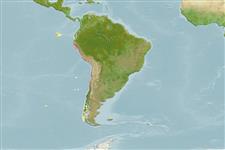>
Blenniiformes (Blennies) >
Blenniidae (Combtooth blennies) > Salariinae
Etymology: Scartichthys: Greek, skaritis, -idos = a jewel stone with the colour of the fish scarus (Ref. 45335); viridis: Latin, viridis = green; refers to the green body coloration in life (Ref. 10696).
More on author: Valenciennes.
Environment: milieu / climate zone / depth range / distribution range
Ökologie
seewasser demersal; tiefenbereich 0 - 10 m (Ref. 10696). Subtropical
Southeast Pacific: Independencia Bay, Peru to Valparaiso, Chile.
Size / Gewicht / Alter
Maturity: Lm ? range ? - ? cm
Max length : 19.7 cm SL Männchen/unbestimmt; (Ref. 10696)
Rückenflossenstacheln (insgesamt): 12; Rückenflossenweichstrahlen (insgesamt): 17-19; Afterflossenstacheln 2; Afterflossenweichstrahlen: 19 - 20. Distinctive in having a relatively uniformly pigmented body without spots; further differentiated from S. gigas and S. variolatus in having a high number of dentary teeth, 106-131 (versus 93 or fewer).
Adults are found in tide pools and rocky shore areas. Are primarily herbivorous (Ref. 9032). Selectively feed on the green algae Ulva, Enteromorpha, as juveniles and favor red algae Gelidium as adults (Ref. 94105). Oviparous. Eggs are demersal and adhesive (Ref. 205), and are attached to the substrate via a filamentous, adhesive pad or pedestal (Ref. 94114). Larvae are planktonic, often found in shallow, coastal waters (Ref. 94114).
Life cycle and mating behavior
Geschlechtsreife | Fortpflanzung | Ablaichen | Eier | Fecundity | Larven
Oviparous, distinct pairing (Ref. 205).
Williams, J.T., 1990. Phylogenetic relationships and revision of the blenniid fish genus Scartichthys. Smith. Contrib. Zool. 492:1-30. (Ref. 10696)
IUCN Rote Liste Status (Ref. 130435)
Bedrohung für Menschen
Harmless
Nutzung durch Menschen
Mehr Information
ReferenzenAquakulturAquakultur ProfilZuchtlinienGenetikElectrophoresesVererbbarkeitKrankheitenVerarbeitungNutrientsMass conversion
PartnerBilderStamps, Coins Misc.LauteCiguateraGeschwindigkeitSchwimmstilKiemenoberflächeOtolithsGehirngrößeSehfähigkeit
Tools
Zusatzinformationen
Download XML
Internet Quellen
Estimates based on models
Preferred temperature (Ref.
123201): 14.8 - 20.6, mean 19.5 °C (based on 102 cells).
Phylogenetic diversity index (Ref.
82804): PD
50 = 0.5625 [Uniqueness, from 0.5 = low to 2.0 = high].
Bayesian length-weight: a=0.00661 (0.00340 - 0.01283), b=2.96 (2.79 - 3.13), in cm total length, based on LWR estimates for this species & (Sub)family-body (Ref.
93245).
Trophic level (Ref.
69278): 2.2 ±0.1 se; based on diet studies.
Widerstandsfähigkeit (Ref.
120179): mittel, Verdopplung der Population dauert 1,4 - 4,4 Jahre. (Assuming tm=1 and Fec=100-1000).
Fishing Vulnerability (Ref.
59153): Low vulnerability (14 of 100).
Nutrients (Ref.
124155): Calcium = 172 [83, 366] mg/100g; Iron = 1.23 [0.71, 2.35] mg/100g; Protein = 18 [17, 19] %; Omega3 = 0.175 [0.091, 0.332] g/100g; Selenium = 16.5 [7.7, 38.1] μg/100g; VitaminA = 16.7 [4.3, 63.8] μg/100g; Zinc = 1.4 [0.9, 2.1] mg/100g (wet weight);
